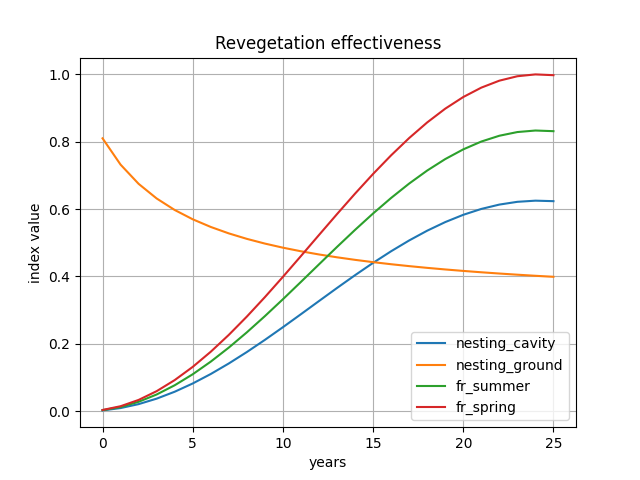About the science
The Simulation Tool is built upon the
NatCap InVEST
software and, specifically, software's the Crop Pollination module.
For detailed information on the Crop Pollination model, please refer
to the module's
official documentation.
In essence, the model uses estimates of habitat and nesting resources for a set of wild bee species, which are key animal pollinators for crops. These two factors are used to calculate an index of wild pollinator abundance for each of the pixels within the space of the farm drawn on the map. The model then calculates an index of the contribution wild pollinators make to the scpecified crop, based upon bee abundance and the dependence of the crop on pollination. The overall result is an indication of how yield can be affected as revegetation is added to farms. The addition of food and nesting resources allows bees to increase crop pollination, with an associated impact on yield.
Typically, the yield impact is crop and location-specific. As of November 2020, the Pollin8 Simulation Tool is running v3.8.9 of the INVEST Crop Pollination software. Within the project, we have created a network-accessible service from the INVEST Crop Pollination model, which is feely available for re-use. The source for this service is available on github
Bees and agriculture
Crops vary considerably in their reliance on animal pollination. Some crops, such as almonds, apples and pears and lucerne depend almost entirely on insect pollination for fruit, nut and seed production. Intensive agriculture and landscape fragmentation have reduced support for insects and connectivity in the landscape. As a result, crop pollination is increasingly relying on services from a single species: the European honey bee – in both managed and feral hives. This reliance on a single species is risky. Feral honey bee hives will decimate after incursion of the Varroa mite, which has already invaded all countries except Australia. This will result in pollination deficits and drive up the prices for managed hives. In preparation for this, we promote sustainable management of native pollinator in agricultural landscapes. We aim to achieve this through bolstering native crop pollinating species through providing them with food and shelter.Setting realistic goals
This web tool can assist in selecting plant species that are locally adapted and provide food for crop pollinating bees. Such plantings may also help to realise co-benefits such as fire abatement, shade and shelter for livestock, biological control of insect pests, erosion control, salinity mitigation and drought resistance, or simply just to increase to biodiversity at a site level. Plantings for co-benefits are not the same as ecosystem restoration. If the latter is your goal, please consult experts organisations (Land care, NRM, Local community groups)A diverse range of plants
Planting a broader range of species is important to provide pollinators with sustenance. Smaller plants may provide resources and co-benefits within the first couple of seasons, but bushes and trees will create the microclimate in which these smaller plants can thrive, and provide more ecosystem services in the long run. So our advice is aim for structural and species diversity. Locality and soil are important to assist in plant selection. Existing remnant vegetation can be informative, but not all plants are easy to grow! Our advice focuses on plants that can be obtained and are locally adapted.Resource provision for pollinators
All crops except almonds are visited by a wide variety of native bee species. Some species are present year-round (feral honey bees), others often have multiple generations per year (furrow and blue-banded bees). This implies that bees need sustenance from early spring through to late autumn. Bees rely completely on flowers for food, as they only eat nectar and pollen. Nectar provides energy (carbohydrate), whilst pollen gives vital proteins and fats required to rear offspring. As a general aim, three pollen and three nectar resources should be present at any one time.Using the Tool
This plant selector encompasses six Natural Resources Management regions in the temperate agricultural regions of South Australia. These regions have diverse range of vegetation communities, and at the farm level, many revegetation scenarios are possible. While the pollinator selector is prescriptive, we recommend working with local restoration professionals from an early stage when undertaking a revegetation project. Such collaboration will also ensure that the proposed revegetation is suitable for the chosen site.Plant form (e.g. understorey, midstorey and overstorey), flowering onset and flowing abundance are important factors for the provision of pollinator resources so understanding the trade-offs between these factors is important for planning the best mix of species for a site.
For example, overstorey species will produce the greatest amount of habitat and flowering per plant and will therefore have the greatest effect on crop pollinators however, overstorey plants may not be reproductive (e.g. producing flowers) for 6-10 years and possibly won’t produce nesting cavities for 20 years.
Mid story shrub layers will establish nesting and flowering resources within 1-2 years although planting them too closely will cause competition between plants reducing the overall fitness along with decreasing available ground nesting bee habitat.
Understory species have the ability to produce resources very quickly however they are small, and due to their often short lifespans might require seasonal replanting. Selecting a diverse mix of plant species and forms that are suited to the site is the most likely way of ensuring a sustainable revegetation project.
